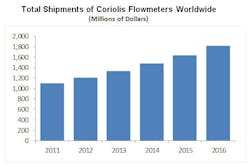According to a recent study from Flow Research, the increased cost of oil and heightened demand for natural gas has put a premium on custody transfer in the flowmeter markets. Coriolis flowmeter suppliers have responded with an entirely new line of Coriolis flowmeters: those with line sizes of 8 to 14 in. Formerly, only Rheonik (now part of GE Measurement) offered Coriolis meters in line sizes larger than 6 in. Now other suppliers have jumped in to take advantage of the growing demand for these high-value applications. The companies include Micro Motion (part of Emerson Process Management), Endress+Hauser and Krohne.
Crude oil is now selling in the range of $100 per barrel. The increased value of oil is placing a premium on both accuracy and reliability in custody transfer measurements—where ownership of the product is transferred from one party to another. While Coriolis, ultrasonic and differential pressure (DP) flowmeters are used for this purpose, their high accuracy and reliability make Coriolis meters very desirable for custody transfer. Their chief drawback is their line size limitation: the largest Coriolis flowmeter now made has a 14-in. diameter—although it can accommodate a 16-in. size. Most of these large line size meters are designed for custody transfer applications.
Custody transfer of natural gas presents a different situation. Many natural gas pipelines range in size from 20 to 42 in., putting them out of reach of Coriolis meters. Here ultrasonic and differential pressure flowmeters still predominate. Gases present a more difficult application for Coriolis meters than liquids, due to their lower density values. However, Coriolis meters are still used for custody transfer of natural gas in the lower line sizes. The large majority of Coriolis meters are still used for line size of two inches and under, whether for gases or liquids.
A research study from Flow Research, The World Market for Coriolis Flowmeters, 4th Edition, addresses the issue of large line sizes, along with other growth factors. The study finds that the Coriolis flowmeter market is among today’s fastest growing flowmeter markets, spurred by growing energy requirements. Worldwide sales for Coriolis flowmeters in 2011 were $1.1 billion, with a projected compound annual growth rate (CAGR) of 10.6% through 2016. The forecast is for the worldwide Coriolis market to exceed $1.8 billion in 2016.
The study also finds that Coriolis flowmeters are the most accurate meter available on the market today, and that end-users continue to view this quality as decisive within many of their measurement applications. Coriolis flowmeter users across the globe—including China, where the growth rate is highest—are making use of the large line size meters introduced by major suppliers during the last few years. And the worldwide growth in liquefied natural gas (LNG) as an energy source is another real driver of Coriolis sales. Flow Research expects this trend to continue.
The largest single industry segment for Coriolis flowmeter usage remains chemical, where growth will be strong throughout the study period. The food & beverage and pharmaceutical industries also contain a significant number of users. The study also found that the downstream oil & gas industry presents interesting new opportunities for Coriolis meters to loosen the hold that traditional technologies have had on this market.
According to Dr. Jesse Yoder, president of Flow Research, there are multiple factors currently driving this market: “Increased demands to measure high-value liquids and gases are generating more demand for Coriolis flowmeters. Coriolis meters are still the most accurate type of flowmeter made. Suppliers continue to make technological improvements to these meters. And straight tube designs have been effective in reducing fluid build-up and pressure drop. Large line size meters are addressing a whole new range of applications. The future looks very bright for Coriolis flowmeters.”
Source: Flow Research


